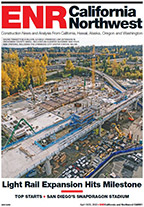Utah-based Intermountain Healthcare has invested more than $1.2 billion in new and upgraded medical facilities since 2005, including four new facilities in Utah stretching from Tremonton in the north to St. George in the south.
The investment has been a major boon to the struggling local construction market.
“There’s no doubt Intermountain Healthcare has been a major contributor to the vitality that Utah’s construction industry has had over the past five years,” says Rich Thorn, president/CEO of the Associated General Contractors of Utah. “They’ve put literally thousands of people to work and have invested hundreds of millions of dollars into our communities.”
Intermountain’s flagship hospital – the $560-million Intermountain Medical Center in Murray, Utah – opened in October 2007 and is one of the largest and most technologically advanced full-service medical facilities in the western United States.
In addition, Intermountain completed four new Utah facilities in 2009: the $162-million Riverton Hospital in Riverton, $83-million Park City Medical Center in Park City, $61.8-million Dixie Health and Performance Center in St. George and $24.6-million Bear River Valley Hospital in Tremonton.
On Solid Ground
Intermountain has also invested significantly into upgrading and renovating various smaller medical facilities and office buildings, with a keen interest in seismic safety issues because of the potential risk of a future major earthquake along the Wasatch Fault in Utah.
“Intermountain puts you in a partnership position.It’s a collaborative and trusting process.”
“We’re in better shape than anyone I know of in terms of handling seismic issues,” says Steve Dibble, the company’s director of facilities development. “We’re lucky to have good firms locally with a strong background in health-care design.”
All of Intermountain’s new facilities are designed to ensure optimum public safety, and the firm has incorporated various structural engineering systems to meet that need.
“We want our employees and patients to be safe,” says D.R. Gardner, Intermountain’s vice president of capital planning and development. “It took a significant effort to spend those dollars. It was a major push for us to make sure seismic issues are taken care of.”
Dorian Adams, a principal with Reaveley Engineers + Associates of Salt Lake City, who helped design the structural elements at two of the new hospitals, says: “Every time they made a choice, we felt we could back them up 100%. It’s nice to have a client that understands issues and can understand where you’re coming from when you’re making recommendations for a higher level of safety.”
Dibble adds: “The structures are designed to meet or exceed the international building code that requires all building components such as ceiling systems, utility connections, HVAC equipment, overhead lights and heavy imaging equipment to be designed to remain in place during an earthquake and that the buildings remain functional after an earthquake.”
Smart Client
In addition to hiring qualified A/E/C firms, Intermountain has an inhouse project management team consisting of three construction managers who manage two to four construction projects at any given time, and firms that work for Intermountain say they appreciate the level of detail and scrutiny the firm brings to the table on every project.
“I get involved early in the design process with estimating, constructability and scheduling,” says Blake Court, a project executive the past five years with Jacobsen Construction of Salt Lake City. Court spent 11 years working for the Dept. of Veteran Affairs, where he learned to appreciate the nuances of health care required by a full-service hospital.
“Intermountain has streamlined its systems and has the proper people in place, along with support from individual divisions,” Court adds. “Matters are resolved before we even begin certain (construction) processes.”
Rob Moore, president of Big-D Construction of Salt Lake City, says Intermountain “puts you in a partnership position. It’s a collaborative and trusting process. There is not a better owner in state of Utah. They treat you with utmost respect, and your goal is to over deliver for them.
John Evans, vice president with Okland Construction of Salt Lake City, calls Intermountain an “organized owner. They’re sophisticated from our standpoint in that we don’t have to guess or fill in gaps during the construction process. They have people that know their jobs. They know how to put buildings together from a design and construction standpoint.”






Post a comment to this article
Report Abusive Comment